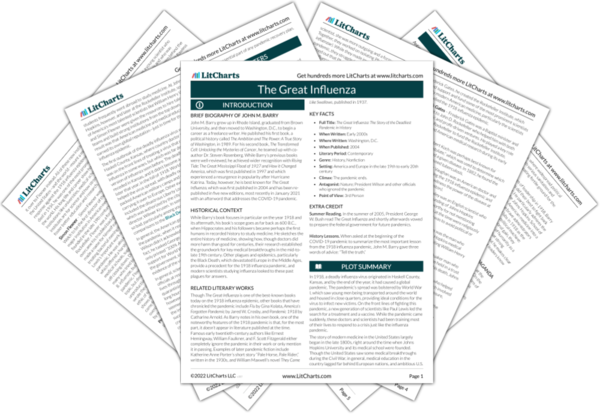The question of how the truth gets told is at the center of John Barry’s The Great Influenza. On the one hand, it is a book about extreme distortions of the truth. World War I led to the publication of tremendous amounts of propaganda in the press and the censorship of anything that might threaten the war effort—even in countries with a supposedly free press like the United States. The so-called “Spanish influenza” of 1918 didn’t originate in Spain or even hit the country with particular ferocity. It just happened that Spanish journalists were some of the only ones to write about the pandemic honestly, because Spain was neutral in World War I (and so there was no government pressure to censor negative news stories). By contrast, American newspapers, at the urging of President Woodrow Wilson and his advisors like George Creel, printed very little about the pandemic, even though it likely originated in Haskell County, Kansas and had major early outbreaks in U.S. Army camps. This decision to hide bad news didn’t stop the spread of fear in the U.S.—in fact, it did the opposite, because people could see the devastation of the influenza epidemic with their own eyes, which recalled the Black Death. This grim reality led Americans to feel doubt and paranoia when newspapers refused to mention the subject.
Still, while these distortions of the truth were being printed, others sought to illuminate the truth. The influenza epidemic coincided with the early days of modern American medical research, and investigators like Welch, Lewis, Avery, and Cole all worked tirelessly in their labs, seeking to understand influenza and particularly to identify its pathogen, which was the first step toward finding a cure or vaccine. Though the desperate situation meant that they couldn’t always be as methodical as they would have been pre-pandemic, they followed the scientific method and took a hands-on approach to research, overseeing the most important lab work themselves. These investigators learned frightening truths about the influenza virus and its ability to kill, but learning these truths was necessary to help mitigate the pandemic. By presenting scientists’ quest for truth alongside politicians’ and the media’s efforts to cover it up, Barry contends that while the truth is often scary, it is better for society to face it and study it instead of trying to cover it up.
Truth, Free Press, and Propaganda ThemeTracker

Truth, Free Press, and Propaganda Quotes in The Great Influenza
Wilson had demanded that “the spirit of ruthless brutality. . . enter into the very fibre of national life.” To carry out that charge, Creel had wanted to create “one white-hot mass,” a mass driven by “deathless determination.” He was doing so. This was truly total war, and that totality truly included the medical profession.
The Liberty Loan campaign would raise millions of dollars in Philadelphia alone. The city had a quota to meet. Central to meeting that quota was a parade scheduled for September 28.
Two days after Philadelphia’s Liberty Loan parade, Wilmer Krusen had issued that somber statement, that the epidemic in the civilian population “was assuming the type found in naval stations and cantonments.”
This was influenza, only influenza.
As terrifying as the disease was, the press made it more so. They terrified by making little of it, for what officials and the press said bore no relationship to what people saw and touched and smelled and endured. People could not trust what they read. Uncertainty follows distrust, fear follows uncertainty, and, under conditions such as these, terror follows fear.
By World War I, the revolution in American medicine led by William Welch had triumphed. That revolution had radically transformed American medicine, forcing its teaching, research, art, and practice through the filter of science.
The greatest questions remained the simplest ones: What caused influenza? What was the pathogen? Was Pfeiffer right when he identified a cause and named it Bacillus influenzae? And if he was not right, then what did cause it? What was the killer?
So the final lesson of 1918, a simple one yet most difficult to execute, is that those who occupy positions of authority must retain the public’s trust. The way to do that is to distort nothing, to put the best face on nothing, to try to manipulate no one.











